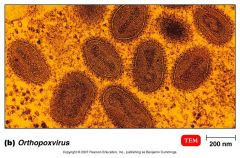![]()
![]()
![]()
Use LEFT and RIGHT arrow keys to navigate between flashcards;
Use UP and DOWN arrow keys to flip the card;
H to show hint;
A reads text to speech;
10 Cards in this Set
- Front
- Back
|
viruses characteristics
|
infectious particle,always contains
DNA or RNA but not both; a protein coat - capsid; technically not alive |
|
|
virion
|
a complete, full developed, infectious viral particle;
vehicle of transmission;20 to 1000 nm in length |
|
|
viral nucleic acid
|
Seven classes of viruses are based on the nature of their nucleic acid;may be either DNA or RNA, but never both;may be double stranded or single stranded
|
|
|
capsid
|
in some cases, the capsid is covered by an envelop
usually derived from the host cell membrane;spikes are viral carbohydrate-protein (i.e. glycoproteins) complexes that stick out from the surface of the envelope |
|
|
spikes
|
ability of certain viruses (such as Influenzavirus) to clump red blood cells;hemagglutination - basis of useful laboratory tests
|
|
|
Some virusus
|
can mutate before immune system can respond
|
|
|
Ebola
|
is an enveloped helical virus
|
|

|
Variola virus;
|
|
|
cytopathic effect (CPE)
|
disruption or deterioration of the cells; use for cell cultures
|
|
|
types of cell lines are?
|
primary cell lines=derived from tissue slices
diploid cell lines=from human embryos continuous cell lines=immortal cell lines;from cancerous cells - transformed cells;HeLa cells from Henrietta Lacks’ cervical cancer |

